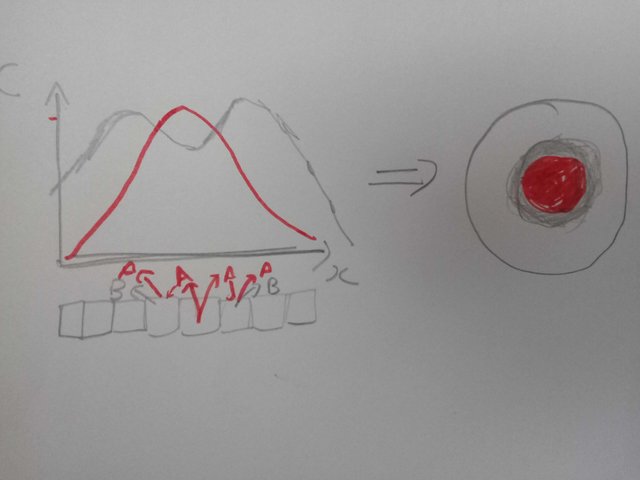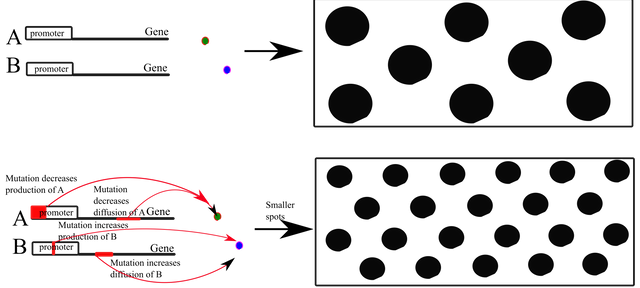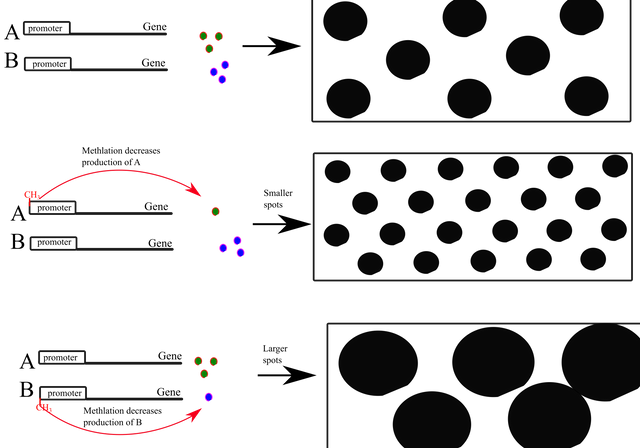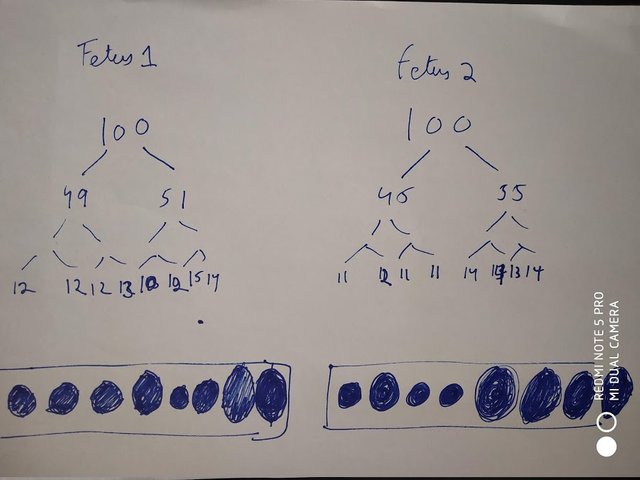How unique are you? The science of individual differences.
In one of my previous blogs, we explored the question - why are we not spherical? We saw how the symmetry of embryo is broken giving us all our shapes. But today I want to ask, why don't we all look the same. Why factors that break the symmetry, don't break it the same way in all of us? More importantly, what mechanism still ensures uniqueness in identical twins?

Image sources - Reaction diffusion equation plot byHuboedeker | CC BY-SA 2.5, Random walk by Sullivan.t.j | CC BY-SA 3.0, Twins by Glow | CC BY-SA 3.0.
People differ in their opinion, their personalities, the way their brain is connected, and subtle patterns on their skin. We all know that our finger prints and retina patterns are unique. Many of these patterns - behavioural and physical, are highly similar in identical twins. Nevertheless, they are not identical. But have you ever wondered that why are we all unique, or is it just me? In this article, I will use simple Turing patterns that arise from his reaction diffusion equations and ask how differences in patterns can arise among different individuals. Using a hypothetical species which has spots on its skin, we will wander through how genes, environment and sheer random walk of molecules create individuality.
A brief recap on how patterns are created
We learnt from Alan Turing that if you take two molecules acting in an activator-inhibitor complex, you can give rise to multiple patterns(see previous blog for details). These molecules can be genes or gene products(proteins) or metabolites produced by these proteins. The activator diffuses from its source and causes the production of another molecule which causes inhibition of activator(or it may even stimulate its own production or both). This can be represented as reaction-diffusion equation where:
Concentration of B is function of concentration of A.
In case where high concentration of morphogen A produces red colour in its surrounding, we saw that for a given value of diffusion coefficient, rate of production of A and B, we would get spot like pattern.

By: @scienceblocks (Also used in my previous blog)
Now, just extrapolate this pattern on entire skin of any animal. Say, a white skin animal with black spots:

@scienceblocks
Given this information, can you think of a way by which individual differences arise? Take this animal with black spots as an example and think, how can we biologically create all kind of variations in patterns of spots.
Story of genetic variations
We all have heard that genes shape how we look, how tall we are and even how we behave. But have you wondered how? It's bit complicated to understand how one becomes taller than the other. However, we can use our simplistic model to understand how mutation in genes can create variation in patterns of spots.

@scienceblocks
Now let's say in the population of our hypothetical organism there exist two varieties. One which have spots with a bigger radius, and another which have spots with smaller radius. So, some researcher goes and sequence this organism and finds that smaller spots are caused by a mutation in A. What could this mutation probably do? Well let's say the gene A was made of 300 nucleotides, making a protein of 100 amino acids. However the mutant of A is an allele which encodes a protein with 10 extra amino acid. Or maybe it is a mutation which changes just one amino acid in the protein. Both making the protein bulky or changing chemical nature of protein surface by changing one amino acid, can affect its rate of diffusion. If, diffusion rate of A becomes slightly less, you would have B inhibiting it before it makes spots of large radius. Similarly, another group of researchers may find another deletion mutation in gene B, which makes it spread faster. And, it would yet again create smaller spots.
However, it's not always necessary to alter the sequence of gene to create variety of patterns. There are regulatory elements - promoters and enhancers in DNA, that controls the rate of production of A or B. Causing a mutation in these regions will affect the creation and destruction term in our equation above. This gives us another mechanism by which harmless mutations can give rise to variety among individuals.
Alright then, slight differences in genetic code of individuals creates variety between them. However do we always need genetic variation to create individual differences? Not really! I mean do you really think all patterns on skin of identical twins would be identical?
How identical are identical twins?
If genes decides all the patterns then why do identical twins have unique fingerprints, retina patterns or that tiny variation in length of blood vessel bifurcation? Well the interesting fact over here is that even though all these patterns are genetically determined and hence similar in identical twins, they are distinguishable(Jain et al., 2002, Daugman et al., 2001, Zhang et al., 2014).
Well, if you don't know what identical twins are let me put it this way - a single sperm fertilise a single egg, forming a zygote. The zygote then divides into multiple cells and initiates the process of embryogenesis. But somewhere in the early stage(morula) it splits. And each set of split then continues to form it's own fetus. Hence, both the fetus will have same genes and same starting conditions to begin with. So where does the difference come from?

@scienceblocks
Now, both the fetus grow separately inside their own placenta. Within each individual placenta these fetuses will be exposed to their own set of environmental variables. For our hypothetical organism with genes A and B if these environment happen to regulate their production or secretion, you will see each child developing it's own pattern. Say in one fetus, the environment causes methylation of promoter of A, but not in another. Hence in this fetus, A will be produced at lower rate. And hence without having a genetic difference you can still produce one child in twin pair with small spots and another one with large. If the methylation in one of the child was in promoter of B then you will have one child with very large spots instead.
However, say we kept the environment and genes and everything the same between twins. Can we get rid of individuality(at least for physical aspects in this case)? Well, NO!
Contribution of Brownian motion

microscopy done by @scienceblocks
Let’s consider identical twins who even share their placenta – monoplacental, monozygotic twins. These twins will have the least amount of environmental variation within them. However, they still have many unique patterns. I even asked this question in my previous blog, to which @mathowl replied correctly that the initial conditions might vary between two fetus. Now what does it mean? Hmm...
Imagine a single cell. Inside every cell there is a fluid called cytoplasm in which molecules and organelles are moving around randomly. This random walk of particles in space is called Brownian motion(Einstein, 1905). The random walk of molecules creates local spatial differences of concentration of different molecules, when you see its snapshot in time. Now if cells divides into two at any point t in time, it never really divides the molecules equally into two daughter cell. One cells may always get a little more or little less of some molecules, just by random chance.
Say, in our hypothetical organism the cells that will produce A, differentiates and divides before they actually start secreting it. Let, the first cell that will form an 'A' producing cell have 100 molecules of A in twins. In first fetus the cells divides to get 49-51 molecules each and in second fetus it gets 45-55 each. They divide further to cells having 24-23-22-29 and then 12-12-12-13-10-12-15-14 in fetus 1. In fetus 2 they divide from 45-55 to 23-22-28-27 to 11-12-11-11-14-14-13-14. If the number of molecules of A in these 8 cells were determinant of how much A will be produced and secreted by these cells, you will see an entirely different pattern of spots on child that developed from fetus 1 vs child that developed from fetus 2. Well, there will be overall similarity, but the arrangement of different size spots will be unique and distinguishable.

However, this doesn’t mean that pattern of blood vessels, retina or finger print are not genetically encoded. They are highly similar between identical twins, but they are distinguishable. Hence, while similarity in patterns is encoded genetically and by shared environment, the uniqueness within individuals still persist. It persists because of inherent randomness of initial conditions. In pop culture you would call this butterfly effect. The small differences in initial conditions, causes noticeable differences over time – in twins for our purpose.
However, you may want to ask that whether these phenotype variations created just by mere noise hold any significance? Seems like it does. From a single cell perceptive a cancer cell may benefit from such noise. Say a drug that was suppose to target some receptor on cancer cells fails to kill them all. Why? Maybe because while dividing rapidly a few of these cancer cells just took very few molecules of that receptor with them. Cohen et al., in 2008 discussed this in how dynamic proteomic state of the cancer cell can cause it to respond uniquely to a drug. Nevertheless, more research is required to estimate the contribution of noise in things other than fingerprints and blood vessel patterns. Think about the complexity of brain. Are the brains of identical twins really identical?
Moreover, noise and epigenetics don't only act during development, they are present throughout our lifetime. Hence, with aging identical twins are bound to become more and more different from each other. And with that remark I will end this article here. Would look forward to your comments and questions.
References
Why are we not spherical - Breaking the symmetry of embryo with Alan Turing.
Alan Turing, 1952, The Chemical basis of Morphogenesis
Albert Einstein, Investigations on theory of Brownian movement, 1905
Signing off
This post has been voted on by the SteemSTEM curation team and voting trail in collaboration with @utopian-io and @curie.
If you appreciate the work we are doing then consider voting all three projects for witness by selecting stem.witness, utopian-io and curie!
For additional information please join us on the SteemSTEM discord and to get to know the rest of the community!
My wife is an identical twin and she is so different in appearance from her sister at this point that many don't realize they're twins. Epigenetics and other environmental factors can really have a major impact on appearance.
Hi @scienceblocks!
Your post was upvoted by utopian.io in cooperation with @steemstem - supporting knowledge, innovation and technological advancement on the Steem Blockchain.
Contribute to Open Source with utopian.io
Learn how to contribute on our website and join the new open source economy.
Want to chat? Join the Utopian Community on Discord https://discord.gg/h52nFrV
Hi @scienceblocks!
Your post was upvoted by @steem-ua, new Steem dApp, using UserAuthority for algorithmic post curation!
Your UA account score is currently 3.203 which ranks you at #8359 across all Steem accounts.
Your rank has dropped 25 places in the last three days (old rank 8334).
In our last Algorithmic Curation Round, consisting of 225 contributions, your post is ranked at #192.
Evaluation of your UA score:
Feel free to join our @steem-ua Discord server
A real informative article, bro. Very well written! 👌
Missed that. And it sounds interesting. I'll read it next, and hopefully even be able to vote on it using a new service that allows you to vote on a post past the 7 days period!
Great post, and I liked how each section predicted and answered the reader's questions from the last section.
Thanks for this comment. Its always motivating to get positive feedback. Also thanks for letting me know about steem forever. Looks like as feature steem needed for long time. I will explore more of it.
I remember from my Biology classes the inactivation of the X chromosomes in females. All cells in a female body have the sexual chromosomal pair as XX. However, they are clever and during development, these inactivate one of those to prevent overflow of information. So in the end there is only one X chromosome active & the other inactive. The catch is, it happens at random unless there is faulty genetic code in one (leading to that being deactivated).
This just makes every woman even more different in they own unique way.
In the end we are sacks of particles with unpredictable (probabilistic) patterns.
Indeed. This will in fact make a very interesting example and something you can observe on spots of cat fur as well. For a 8 cell organism which have identical twin the probability of having two twins exactly the same in terms of X in activation will be 1/28. Now put it on context of an orgnisms with over 10 trillion cells! So identical twin sisters would become unique just be sheer randomness of X inactivation. Thanks for adding this valuable comment. Really appreciate it.
I absolutely forgot that it was the reason about the spots on cat's fur!
Aaand, you are very welcome!
Hi @scienceblocks, I'm @checky ! While checking the mentions made in this post I noticed that @microscopy doesn't exist on Steem. Did you mean to write @microspy ?
If you found this comment useful, consider upvoting it to help keep this bot running. You can see a list of all available commands by replying with
!help.Congratulations,
you just received a 14.08% upvote from @steemhq - Community Bot!
Wanna join and receive free upvotes yourself?

Vote for
steemhq.witnesson Steemit or directly on SteemConnect and join the Community Witness.This service was brought to you by SteemHQ.com